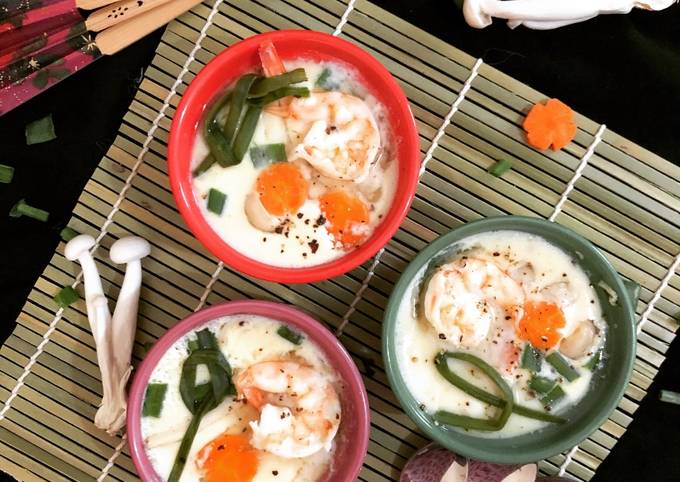
Hey everyone, I hope you are having an incredible day today. Today, I will show you a way to prepare a special dish, chawanmushi (japanese savoury egg custard). It is one of my favorites food recipes. This time, I will make it a little bit unique. This will be really delicious.
Chawanmushi is a traditional Japanese appetiser made from steamed savoury egg custard and full of fillings such as prawns, kamaboko steamed fish cake, shiitake mushrooms and spring onions. For the authentic chawanmushi experience, serve these tasty treats in a small Japanese tea cup. But chawanmushi consists of savoury egg mixture with numerous small pieces of vegetables and meat. Typical ingredients are chicken, prawn (shrimp), white meat fish, shiitake mushrooms, kamaboko (steamed fish paste), gingko nuts, carrot and mitsuba (wild Japanese parsley or the Japanese version of Cryptotaenia) as a garnish on the top.
Chawanmushi (Japanese Savoury Egg Custard) is one of the most popular of current trending foods on earth. It is appreciated by millions every day. It is easy, it’s fast, it tastes delicious. They’re fine and they look wonderful. Chawanmushi (Japanese Savoury Egg Custard) is something which I have loved my whole life.
To get started with this recipe, we must prepare a few components. You can have chawanmushi (japanese savoury egg custard) using 9 ingredients and 9 steps. Here is how you can achieve it.
The ingredients needed to make Chawanmushi (Japanese Savoury Egg Custard):
- Make ready 2 eggs
- Get 1 1/2 cups chicken stock
- Get 1/2 tsp. soya sauce
- Get 1/2 chicken breast, cut into small cubes
- Get 2-3 mushrooms, sliced (I used Shimeji mushrooms)
- Take 1/2 carrot, sliced
- Make ready 3 tbsp. spring onion, chopped
- Make ready 3 prawns, deveined & cleaned
- Take as per taste salt & pepper
It is a type of egg custard steamed in a cup, but it is not sweet. You might find it at sushi restaurants or slightly more formal Japanese restaurants in Japan. "Chawan" means teacup or rice bowl and "mushi" means steamed in Japanese, and it is indeed steamed food in a cup. Chawanmushi's flavor comes mainly from Dashi, soy sauce, and mirin. Chawanmushi (Japanese savory egg custard) This Japanese savory custard is easy to make and incredibly smooth and comforting.
Steps to make Chawanmushi (Japanese Savoury Egg Custard):
- Marinate the chicken cubes and the prawns with a pinch of salt and pepper powder for 5 minutes.
- In a bowl lightly whisk the eggs. Add the stock, soya sauce, pinch of pepper and salt. Mix and strain the egg mix.
- Take 3-4 small ramekins / bowls / cups. Place some chicken cubes in each of them.
- Pour the strained egg mix over it. (Fill only 3/4 of the cup).
- Place some sliced mushrooms, spring onion and carrots.
- Cover with a lid or aluminum foil and steam for 5 minutes.
- Remove the foil & place the prawns in each ramekins. Cover with foil - again & steam for 5 more minutes. Turn the heat off and let it remain - covered for 5 minutes.
- Now it is ready to enjoy.
- Serve them with a sprinkle of some pepper if you wish.
Chawanmushi's flavor comes mainly from Dashi, soy sauce, and mirin. Chawanmushi (Japanese savory egg custard) This Japanese savory custard is easy to make and incredibly smooth and comforting. Change up the fillings to taste as well. Chawanmushi, a savory steamed-egg custard, occupies a unique place in Japanese cuisine - somewhere between elegant delicacy and simple comfort food. Served in a small ceramic cup with a dainty.
So that’s going to wrap this up for this exceptional food chawanmushi (japanese savoury egg custard) recipe. Thank you very much for reading. I am sure that you will make this at home. There is gonna be interesting food in home recipes coming up. Remember to save this page in your browser, and share it to your family, colleague and friends. Thank you for reading. Go on get cooking!